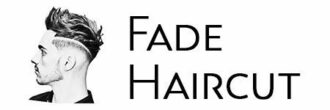What is a Fade Haircut? A fade haircut is a popular men’s hairstyle thanks to social media and sharing platforms, characterized by a gradual transition from longer hair on top to shorter hair on the sides and back. The term “fade” refers to the seamless blending or fading of hair lengths, creating a clean and polished look.
In recent years, the Fade Cut has transitioned from being a source of memes to the latest fashion trend, with many people proudly showcasing their Fade haircuts on social media.
Some barbers even specialize in the style, attracting clients from as far as Canada and Europe for this haircut. It has also been featured in music videos and documentaries, further solidifying its place in popular culture.
Fade haircuts come in various styles, including low fades, mid fades, high fades, and skin fades, depending on where the shorter hair begins on the sides. This versatile hairstyle allows for different top styling options and is known for its clean and contemporary appearance. Fade haircuts have been popular for decades and continue to be a fashionable choice for men of all ages and hair types.
Versatility: Fade haircuts are highly versatile and can be adapted to various hair types and lengths. They work well for individuals with straight, curly, or wavy hair, making it a popular choice for a wide range of people.
Maintenance: Fades require regular maintenance to keep them looking sharp. It’s recommended to visit a barber or stylist every few weeks for touch-ups to maintain the fade line and transition. Home maintenance may be necessary to keep the sides and back neat between appointments.
Styling Options: The hair on top in a fade haircut can be styled in numerous ways. This flexibility allows for various looks, including textured crops, pompadours, slicked-back styles, and more. The choice of styling products and techniques can greatly influence the final appearance.
History: The history of the fade haircut has military origins, dating back to World War II when soldiers adopted the practical “high and tight” cut. Over the years, it has evolved into a stylish and fashionable haircut.
Fade Types:
- Low Fade: The shortest point of the fade is lower on the sides, typically around the ear level.
- Mid Fade: The fade starts at a middle point on the sides, creating a moderate contrast.
- High Fade: The shortest point of the fade begins high on the sides, near the temples.
- Skin Fade: The hair is tapered down to the skin, creating a clean-shaven look on the sides and back.
Cultural Significance: Fade haircuts have cultural significance in various communities and have been associated with specific terms, like “takuache” in Mexican and Latino communities. They may carry a sense of pride and heritage for those who wear them.
Fade haircuts have stood the test of time and continue to be a popular choice for those seeking a clean, contemporary, and stylish appearance. It’s important to communicate your preferences with your barber or stylist to achieve the perfect fade that matches your individual style and features.
This article delves into the history and cultural significance of the fade haircut, highlighting its transformation into a source of pride for those who wear it today.
The Origin of the Fade Haircut
The origin of the fade haircut can be traced back to its military roots, particularly during and after World War II. The fade haircut, originally known as the “military fade” or “high and tight,” was initially a practical and functional haircut adopted by soldiers. Here’s a brief overview of its origin:
World War II and Military Adoption:
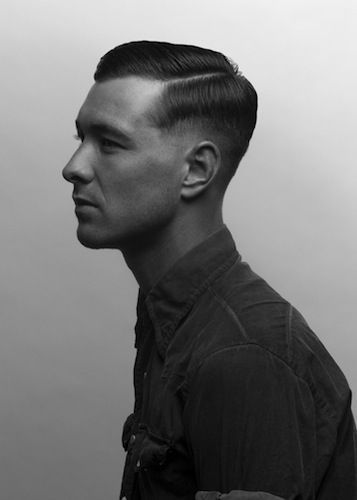
- During World War II, soldiers required a practical and low-maintenance haircut that served several purposes. The military fade was designed to keep hair neatly groomed and reduce the risk of lice infestations.
- The high and tight haircut featured very short sides and back, allowing soldiers to wear their helmets comfortably. It was an ideal choice for maintaining a clean and uniform appearance on the battlefield.
Post-War Popularization:
- After World War II, many soldiers continued to wear the military fade, contributing to its popularity among civilians.
- The style evolved into what is now known as the “Ivy League cut,” which was a more stylish and contemporary take on the military fade.
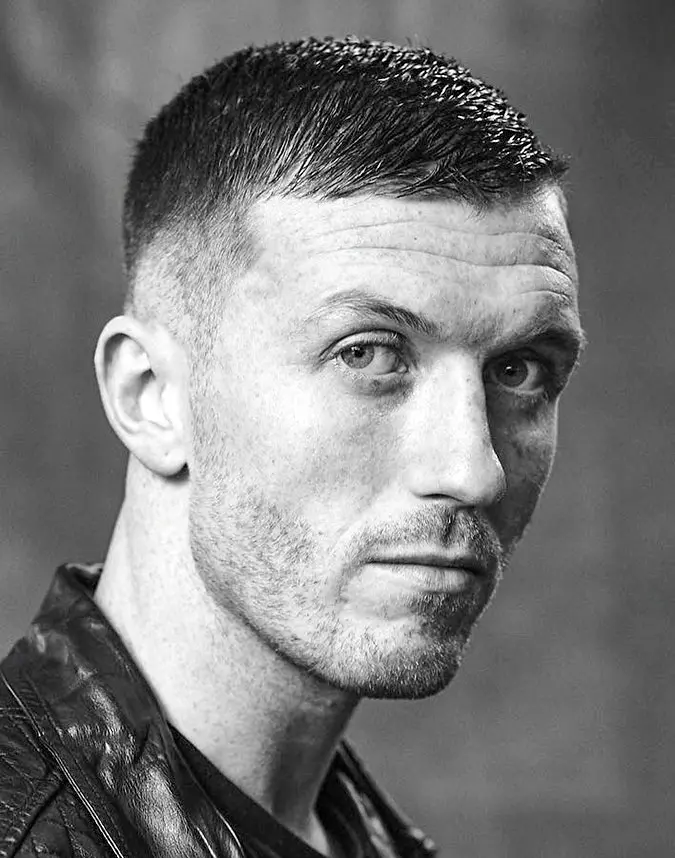
Adaptation and Modern Variations:
- In subsequent decades, the fade haircut continued to evolve, with different variations and styles emerging. This evolution led to low fades, mid fades, high fades, and skin fades, each with its unique look.
- The high-top fade, a prominent style in the 1980s, featured extremely short sides and back, with the hair on top styled into a tall, flat-top shape.
Cultural Significance:
- Over time, the fade haircut has gained cultural significance in various communities. It has been associated with different terms, such as “takuache” in Mexican and Latino communities.
- The style has become more than just a haircut; it carries cultural pride and a sense of identity for those who wear it.
While the fade haircut has military origins, it has evolved into a versatile and stylish hairstyle that transcends cultural and ethnic boundaries. Its history reflects its practicality, adaptability, and enduring appeal in the world of men’s fashion and grooming.
The Evolution of the Fade Haircut
The evolution of the “Fade” haircut is a fascinating journey that spans several decades. This iconic haircut has transformed from its practical military origins into a versatile and stylish hairstyle with the rise of social media. Here’s an overview of the evolution of the fade haircut:
1940s – Military Roots:
- The fade haircut’s origin can be traced back to World War II when soldiers adopted the “military fade” or “high and tight” cut.
- The military fade featured very short sides and back, allowing soldiers to wear their helmets securely and reducing the risk of lice infestations.
1950s – Post-War Popularization:
- After World War II, many soldiers continued to wear the military fade, contributing to its popularity among civilians.
- The style evolved into the “Ivy League cut,” which was a more stylish and contemporary version of the military fade.
1960s – Emergence of Styles:
- In the 1960s, the fade haircut began to take on different variations, reflecting the changing fashion trends of the era.
- The 1960s saw the emergence of high-top fades, where the hair on top was styled into a dramatically tall, flat-top shape.
1980s – High-Top Fades:
- The 1980s witnessed the high-top fade’s rise in popularity, particularly within the African American community.
- This style featured extremely short sides and back, with the hair on top styled into a high, flat-topped shape.
- Hip-hop artists and athletes played a significant role in popularizing the high-top fade.
1990s – Continued Influence:
- The fade haircut remained a prominent part of hip-hop culture in the 1990s.
- Many rappers and artists sported fades in various forms, often with intricate designs or patterns shaved into the sides.
2000s and Beyond – Modern Variations:
- In recent decades, the fade haircut has experienced a resurgence in popularity. Modern variations of the fade include low fades, mid fades, high fades, and skin fades.
- These variations offer individuals a range of options to suit their personal style and facial features.
- Fades are now often paired with various top hairstyles, such as textured crops, pompadours, and slicked-back looks.
Cultural Significance:
- The fade haircut has gained cultural significance in various communities, and it has been associated with specific terms, such as “takuache” in Mexican and Latino communities.
- For many who wear the fade, it represents a source of cultural pride and a way to challenge stereotypes.
The evolution of the fade haircut reflects its adaptability and enduring appeal in the world of men’s fashion and grooming. It has transitioned from its military origins to become a symbol of style, identity, and cultural heritage for many who wear it today.
The Fade Haircut Today: From Ancient Times Till Now
The fade haircut, a contemporary and stylish men’s hairstyle, has a rich history that stretches back to ancient times. This iconic haircut has evolved over the centuries, reflecting changes in fashion, culture, and grooming trends. Today, the fade is not just a haircut but a symbol of personal style and cultural identity.
Ancient Roots:
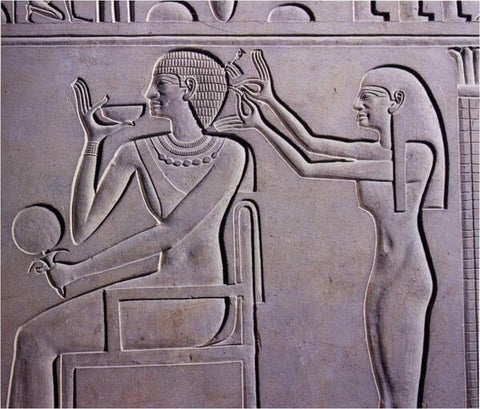
- The concept of cutting hair shorter on the sides and back while leaving the top longer can be traced back to ancient civilizations. Ancient Egyptians, for instance, practiced varying degrees of hair grooming, including styles resembling early fades.
- In ancient Greece, soldiers and athletes sported a similar concept of shorter sides and back, often to symbolize their discipline and prowess.
Military Influence:
- The modern fade’s military influence is unmistakable. It gained prominence during and after World War II when soldiers needed a practical and low-maintenance haircut. The military fade, known as the “high and tight,” featured very short sides and back, allowing soldiers to wear helmets comfortably and maintain a clean, uniform appearance.
- The military fade was not only practical but also helped reduce the risk of lice infestations, which was a significant concern during wartime.
Post-War Popularization:
- After World War II, many former soldiers continued to wear the military fade, contributing to its popularity among civilians. It evolved into the “Ivy League cut,” a more stylish and contemporary version of the military fade.
- The “Ivy League cut” represented a clean and preppy look that became popular among college students and professionals.
Cultural Significance:
- Over time, the fade haircut has gained cultural significance in various communities. It has been associated with specific terms, such as “takuache” in Mexican and Latino communities.
- For many who wear the fade, it represents a source of cultural pride and a way to challenge stereotypes.
Contemporary Variations:
- The fade haircut has continued to evolve into various modern variations, including low fades, mid fades, high fades, and skin fades. These styles allow individuals to choose the level of contrast between the sides and the top.
- Fades are now often paired with a wide range of top hairstyles, from textured crops and pompadours to slicked-back looks and more.
The Fade Today:
- The fade haircut is a symbol of clean lines, precision, and modernity. It remains a popular choice for men of all ages and backgrounds, transcending cultural and ethnic boundaries.
- This versatile hairstyle is known for its adaptability to different hair types, making it suitable for individuals with straight, curly, or wavy hair.
- The fade haircut represents more than just a fashion statement; it embodies the evolution of grooming and the enduring appeal of a well-executed, polished look.
In summary, the fade haircut, with its ancient roots and military influence, has transformed into a versatile and stylish hairstyle that continues to shape modern grooming trends. Its journey from practicality to contemporary fashion reflects its adaptability and enduring appeal in the world of men’s hairstyling.
The Fade haircut has transitioned from being a subject of internet memes to becoming a fashion trend, with numerous online users proudly showcasing their Fade haircuts on social media platforms. Nevertheless, there is still bias associated with this style, as some believe it is predominantly worn by individuals with darker skin tones.
Why is the Fade Cut So Popular?
The Fade Cut has surged in popularity across social media platforms like TikTok, Pinterest, and Instagram. This distinctive style features a fade on the sides and a taper cut in the front and back, although it has been linked to negative perceptions in some cases.
Nevertheless, Edmon Camtos, a skilled barber, and Antony Perton, a professor at the University of Minnesota, believe that this trend is enduring. He suggests that the “Fade Cut” serves as a means for teenagers to express themselves and define their identity.
Perton, with three years of experience in the barbering industry, stresses the importance of keeping up with social media trends to satisfy clients. He notes an increasing number of people requesting “The Fade.”
While some might associate certain haircuts with rebellious teenagers, Perez suggests that other factors, such as socioeconomic status and family background, could be influencing this trend.
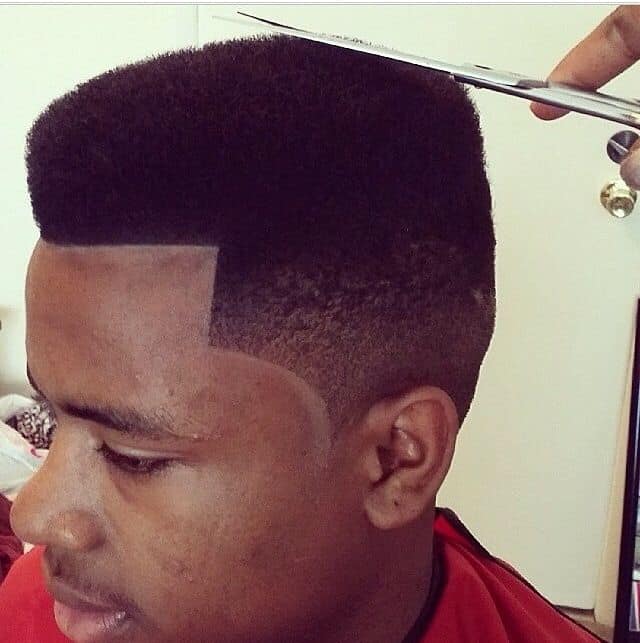
The fade cut has gained immense popularity for several compelling reasons:
- Versatility: The fade cut is incredibly versatile, offering various options such as low fades, mid fades, high fades, and skin fades. This adaptability allows individuals to choose the level of contrast between the sides and the top, suiting different face shapes and personal preferences.
- Clean and Polished Look: Fades provide a clean, polished appearance. The gradual transition from longer hair on top to shorter sides and back creates a neat and well-groomed style, making it suitable for both formal and casual settings.
- Low Maintenance: Fades are relatively low-maintenance haircuts. The shorter sides and back require less styling, and regular touch-ups help maintain the look. This simplicity appeals to those seeking an easy-to-maintain hairstyle.
- Styling Options: The hair on top in a fade cut can be styled in numerous ways, from textured crops and pompadours to slicked-back looks and messy styles. This flexibility allows for a range of fashionable and individualized appearances.
- Cultural Significance: Fades have cultural significance in various communities and have been associated with specific terms, such as “takuache” in Mexican and Latino communities. For many who wear the fade, it represents a source of cultural pride and a way to challenge stereotypes.
- Enduring Popularity: The fade haircut has been popular for decades and has stood the test of time. It appeals to individuals of different generations, making it a timeless choice.
- Celebrity and Cultural Influence: Many celebrities, athletes, and musicians have sported fade haircuts, contributing to their popularity. Their influence on fashion and style trends often leads people to emulate their looks.
- Adaptability to Different Hair Types: Fades work well with various hair types, including straight, curly, and wavy hair. This adaptability ensures that anyone can sport a fade haircut.
- Confidence and Style: The clean lines and precise execution of a fade haircut often boost an individual’s confidence. It can help convey a sense of style and self-assuredness.
- Social Media and Pop Culture: The rise of social media has played a significant role in the popularity of fade haircuts. People showcase their haircuts on platforms like Instagram, TikTok, and YouTube, contributing to the spread of trends and styles.
In summary, the fade cut’s popularity is a result of its adaptability, versatility, low maintenance, and cultural significance. It offers a polished and clean appearance, making it a timeless and widely embraced hairstyle that has transcended generations and continues to be a fashion-forward choice.
How To Get A Fade Cut
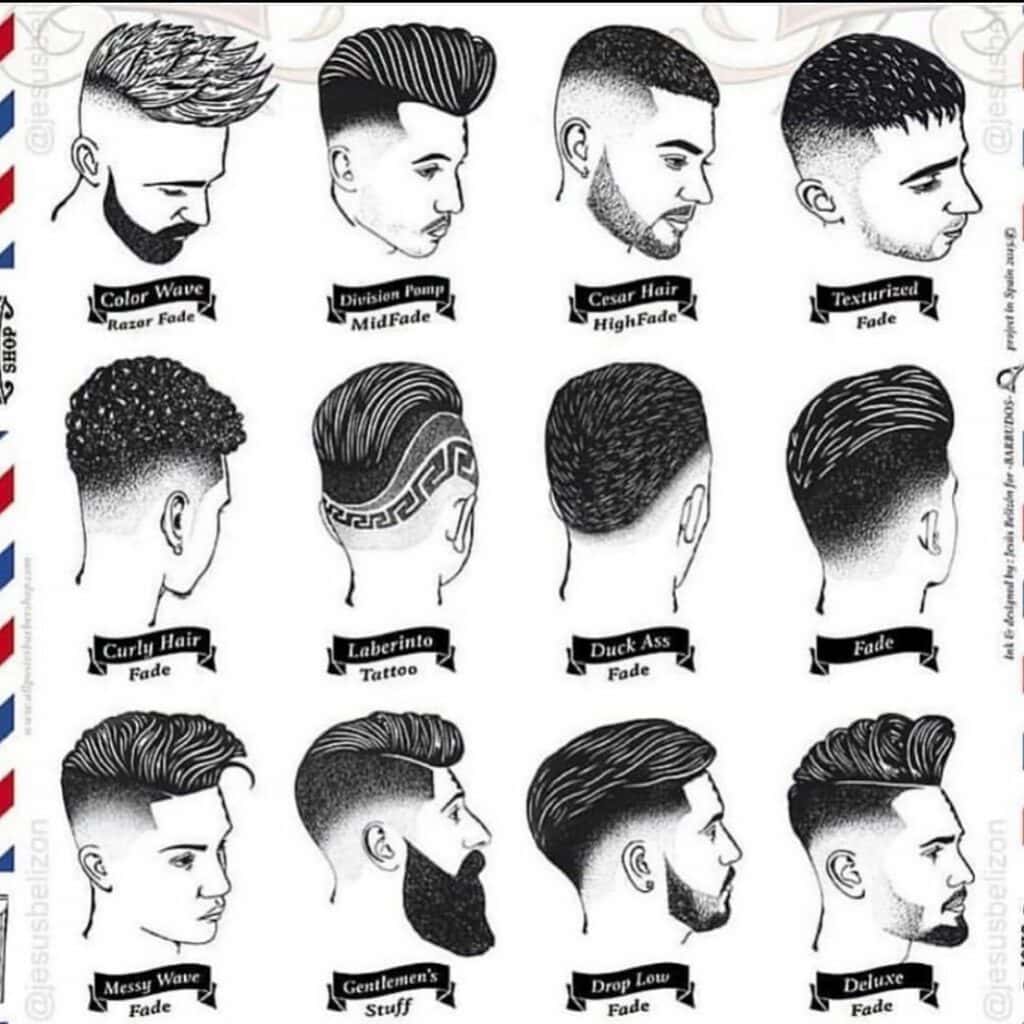
Getting a fade haircut involves several steps, and here’s a general guide on how to achieve this stylish look:
1. Choose Your Fade Type:
- Decide on the type of fade you want. There are different variations, including low fades, mid fades, high fades, and skin fades. The key distinction is where the shorter hair starts on the sides.
2. Find a Skilled Barber:
- Look for a professional barber experienced in creating fade haircuts. Their expertise will ensure a well-executed cut.
3. Discuss Your Preferences:
- Consult with the barber to communicate the specific details of your desired fade. This includes the fade type, the transition point, and the length of the hair on top.
4. Preparation:
- Your barber will start by washing and dampening your hair to prepare it for cutting.
5. Initial Cutting:
- The barber will begin by cutting the hair on top to the desired length. This is the portion you’ll style and shape.
6. Start the Fading Process:
- The fade typically begins with the sides and back. The barber uses clippers with different guard lengths to create a gradual transition from shorter to longer hair.
7. Blending and Precision:
- The barber will carefully blend the different hair lengths to achieve a seamless and clean transition. Precision is crucial in creating a well-executed fade.
8. Styling the Top:
- Once the sides and back are faded to your satisfaction, the barber will move on to the top. They’ll shape and style the hair according to your preferences.
9. Final Touches:
- The barber will make any final adjustments to ensure the fade is polished and even. They may also apply styling products if requested.
10. Maintenance:
- Fades require regular maintenance to keep the clean lines and contrast intact. You’ll need to schedule follow-up appointments with your barber to maintain the look.
11. Styling at Home:
- To maintain your fade’s appearance between barber visits, you can use hair products to style the hair on top according to your chosen look.
How To Ask For The Fade Haircut
When asking for a fade haircut at the barbershop, it’s essential to communicate your preferences clearly. Here’s a guide on how to do it:
1. Choose Your Fade Type:
- Before you go to the barber, decide on the type of fade you want. Low fades start lower on the sides, mid fades start in the middle, high fades start high on the sides, and skin fades taper to the skin. Be specific about your preference.
2. Be Clear About Transition Length:
- Indicate how short you want the faded portion to be. This could be with a specific clipper guard number (e.g., a #2 guard for a longer fade) or a descriptive term (e.g., “short” or “close to the skin”).
3. Decide on Top Length and Style:
- Communicate the length you want for the hair on top of your head. Be specific about the style you’d like (e.g., textured, messy, slicked back, or a specific length in inches).
4. Discuss Any Specific Details:
- If you have any specific details in mind, such as a defined part or a particular shape for the hairline, be sure to mention them.
5. Show Visual References:
- If you have a photo of the desired fade haircut, show it to your barber. Visual references can help ensure you’re both on the same page.
6. Ask for Professional Advice:
- Don’t hesitate to ask your barber for their professional opinion. They can offer guidance on what would work best for your hair type, face shape, and personal style.
7. Clarify Maintenance and Styling:
- Discuss how often you’ll need to come in for maintenance and how to style your fade at home.
8. Confirm Throughout the Process:
- As your barber starts cutting, ask for updates and confirm that the fade is progressing as you requested. This allows for any adjustments if needed.
Clear communication with your barber is crucial to getting the fade haircut you desire. Being specific about the type, length, and style ensures that your barber can create the look you want. .
What Does a Fade Haircut Look Like
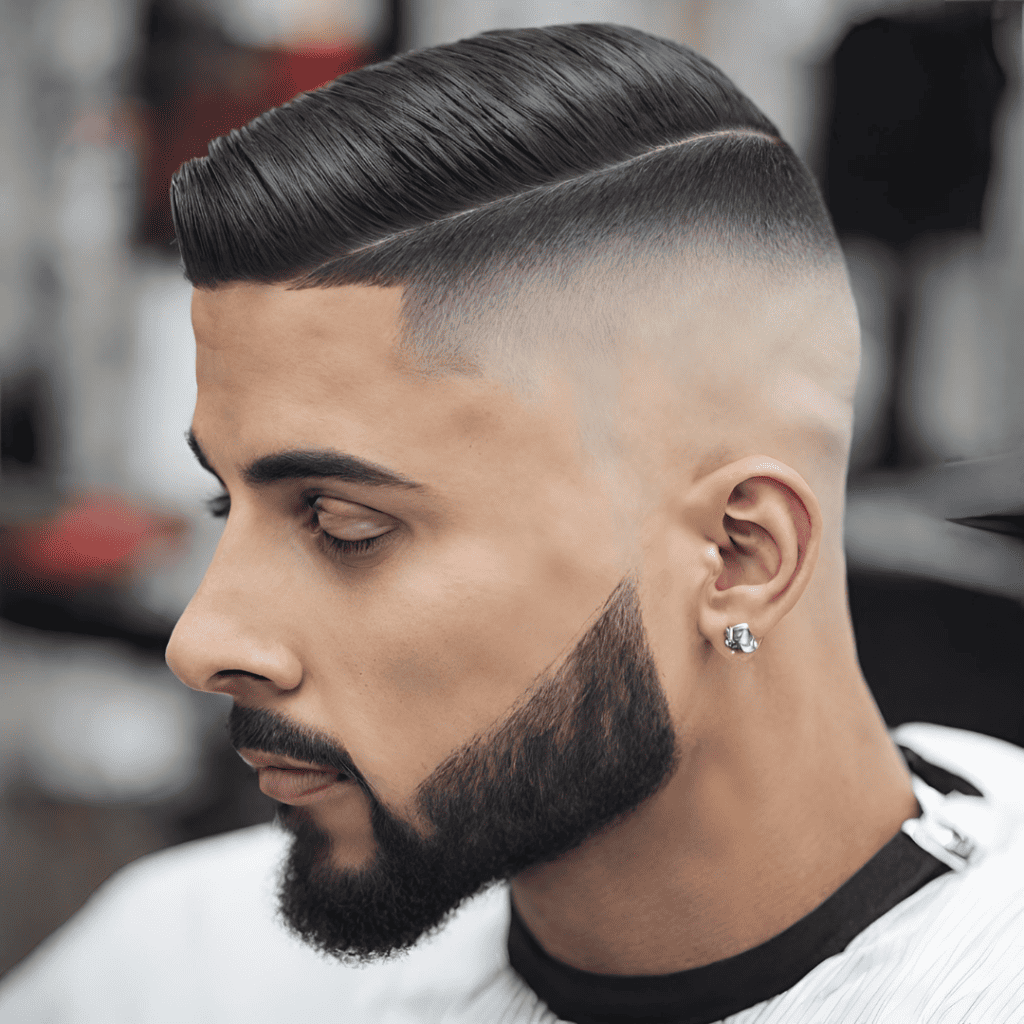
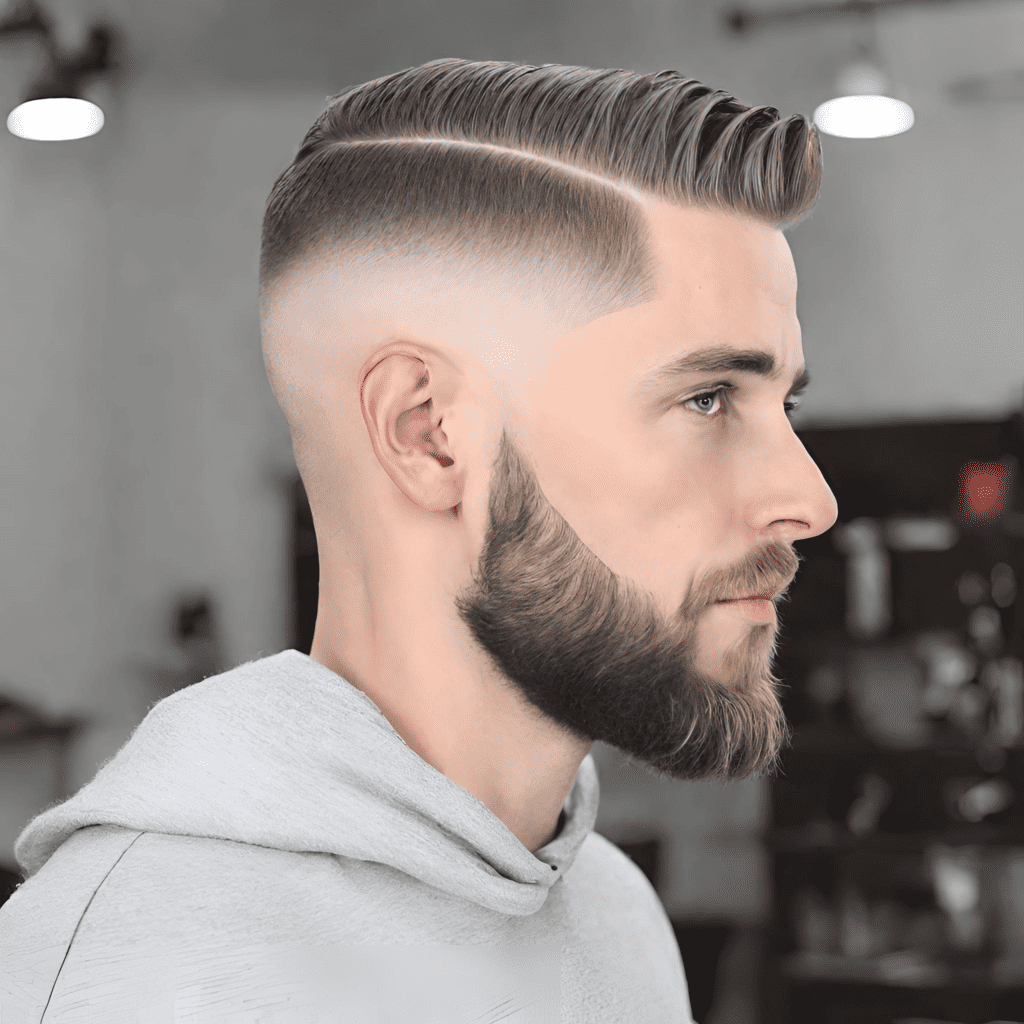
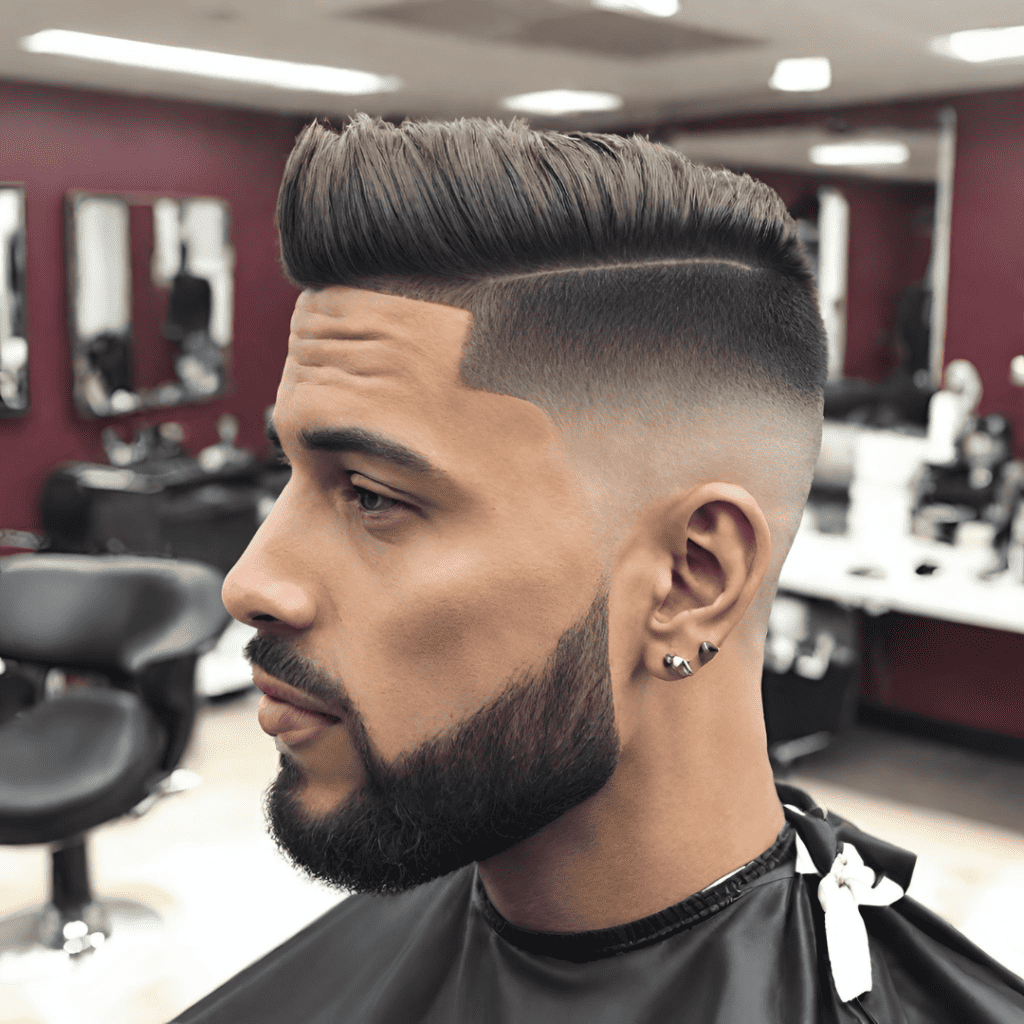
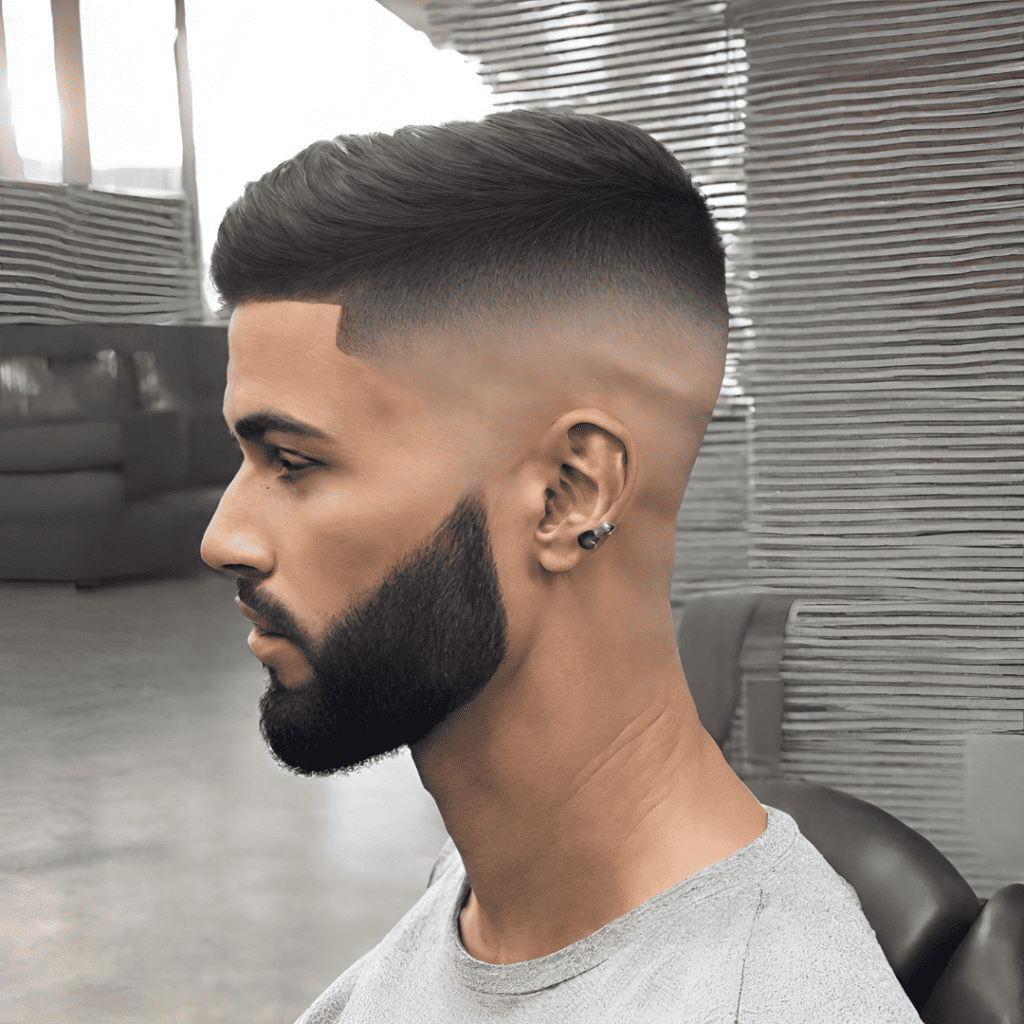
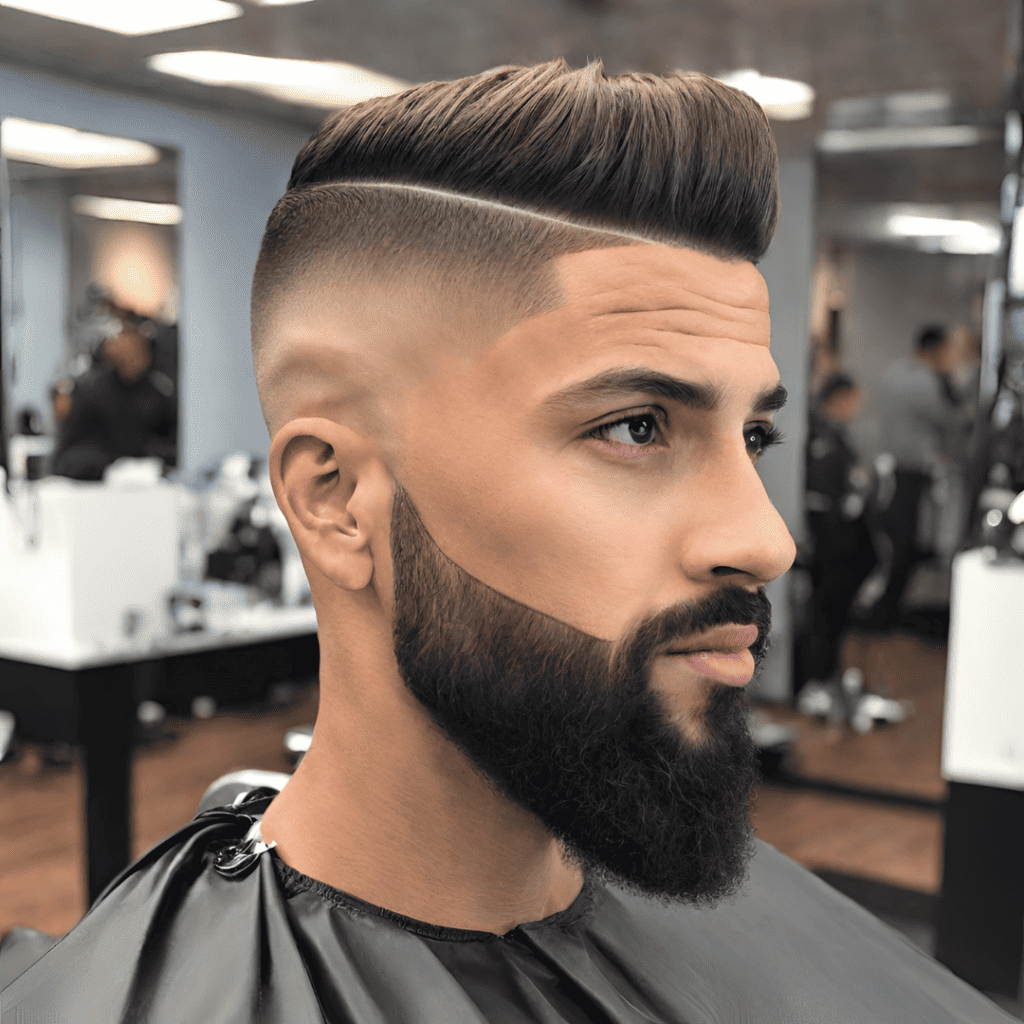
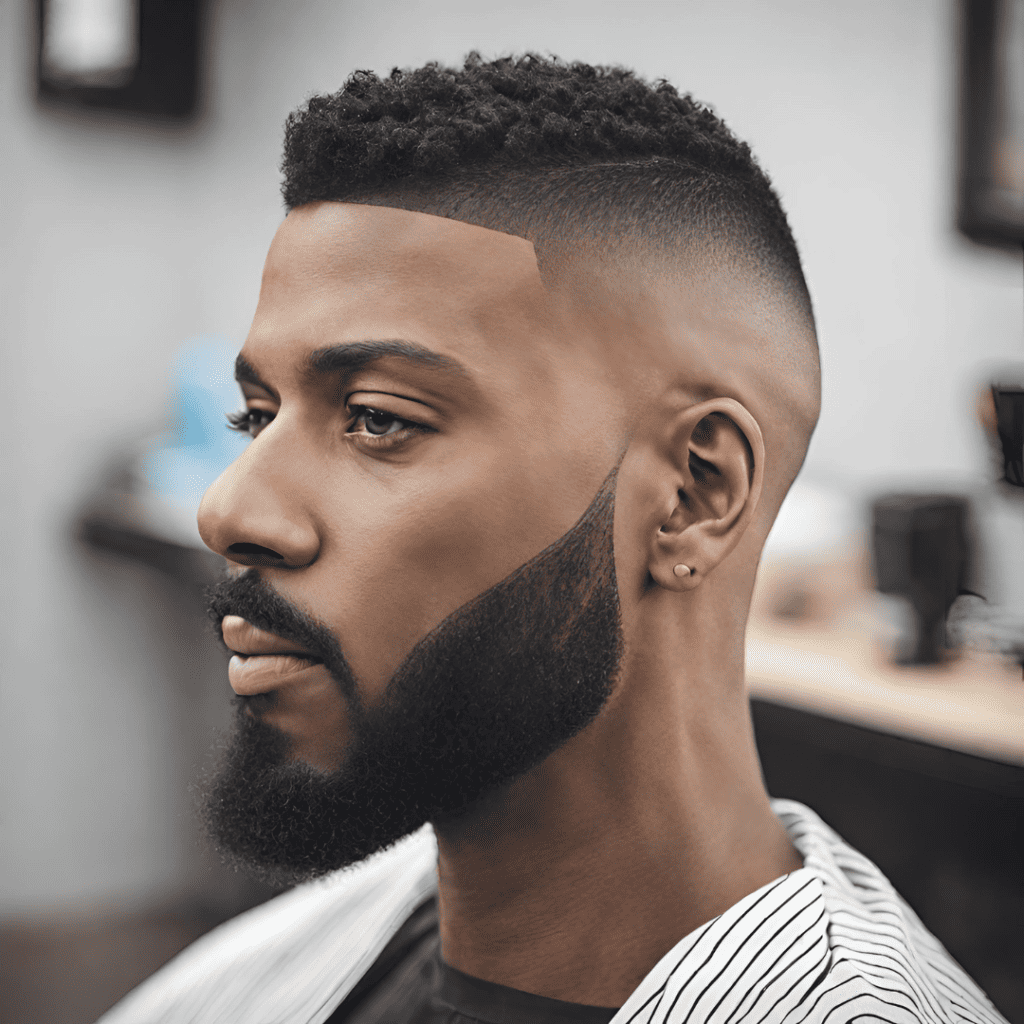

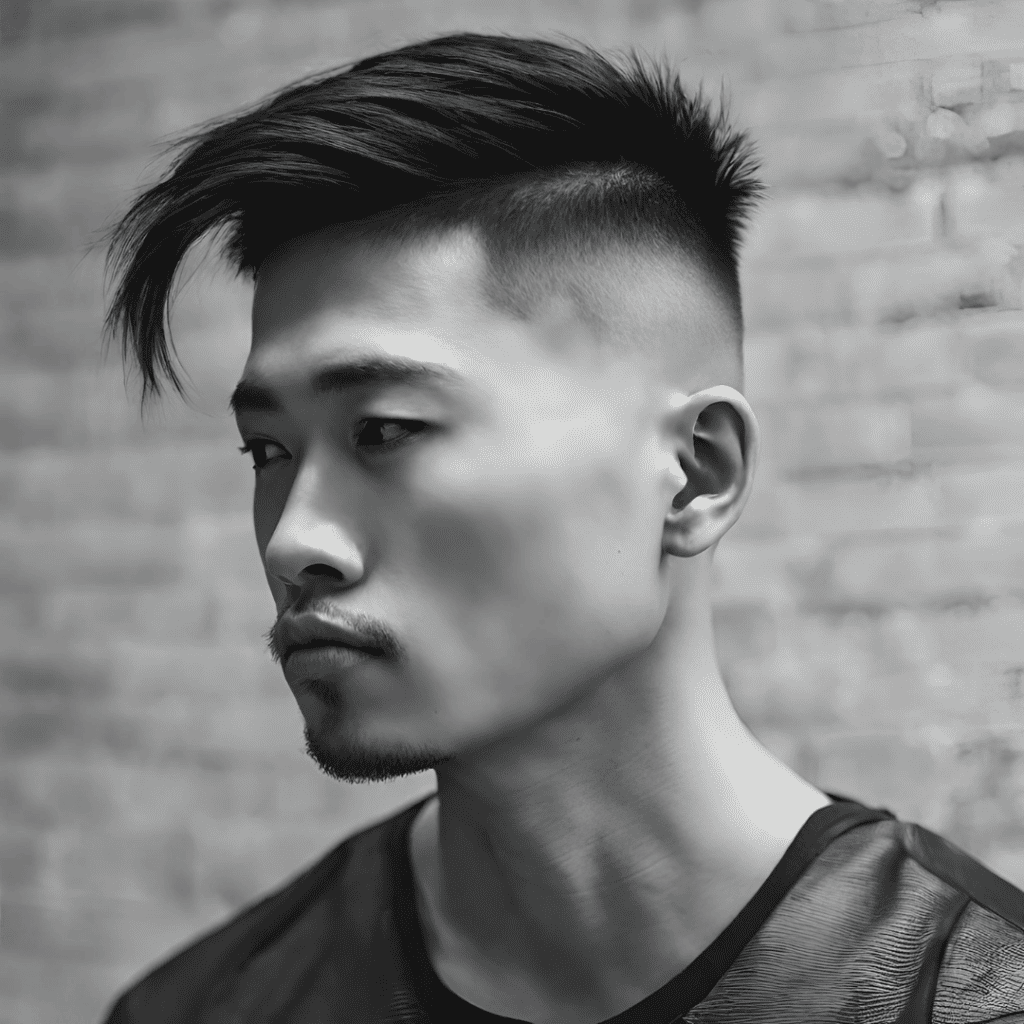
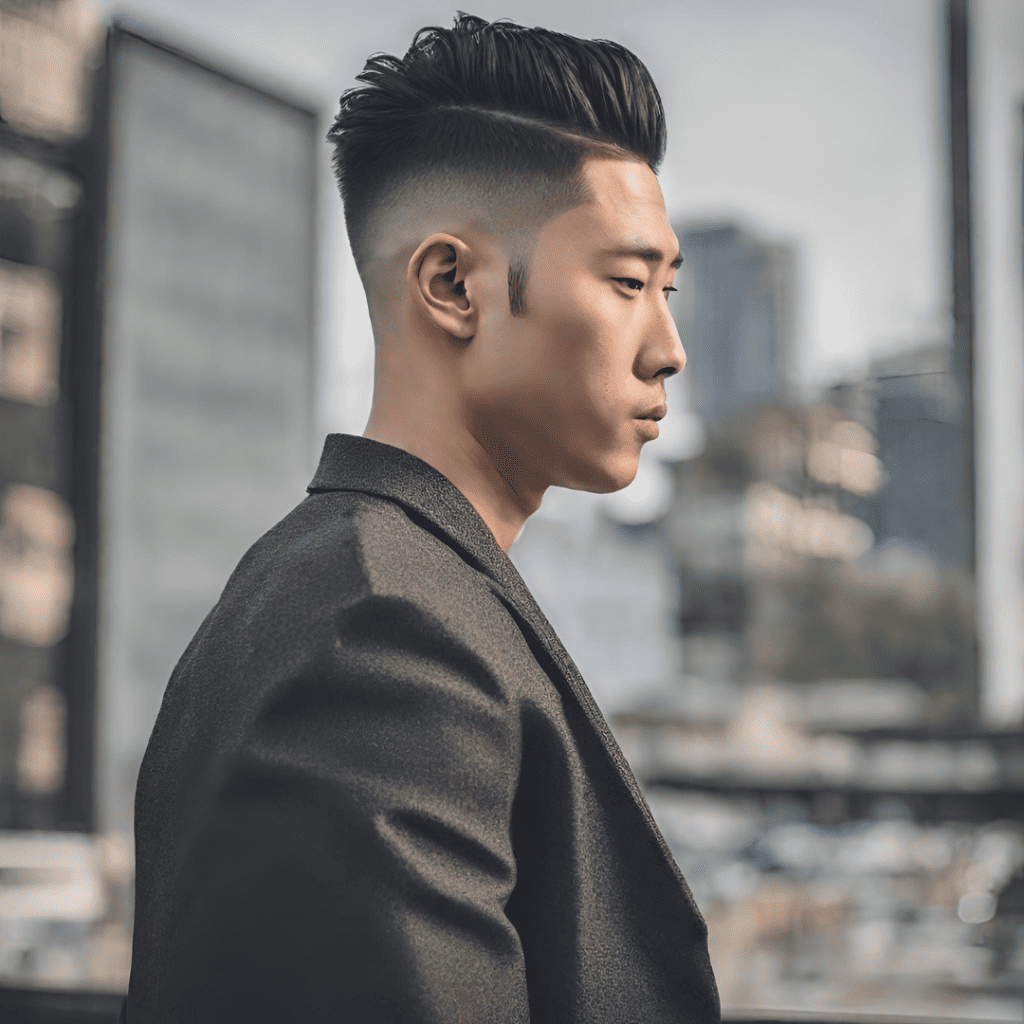
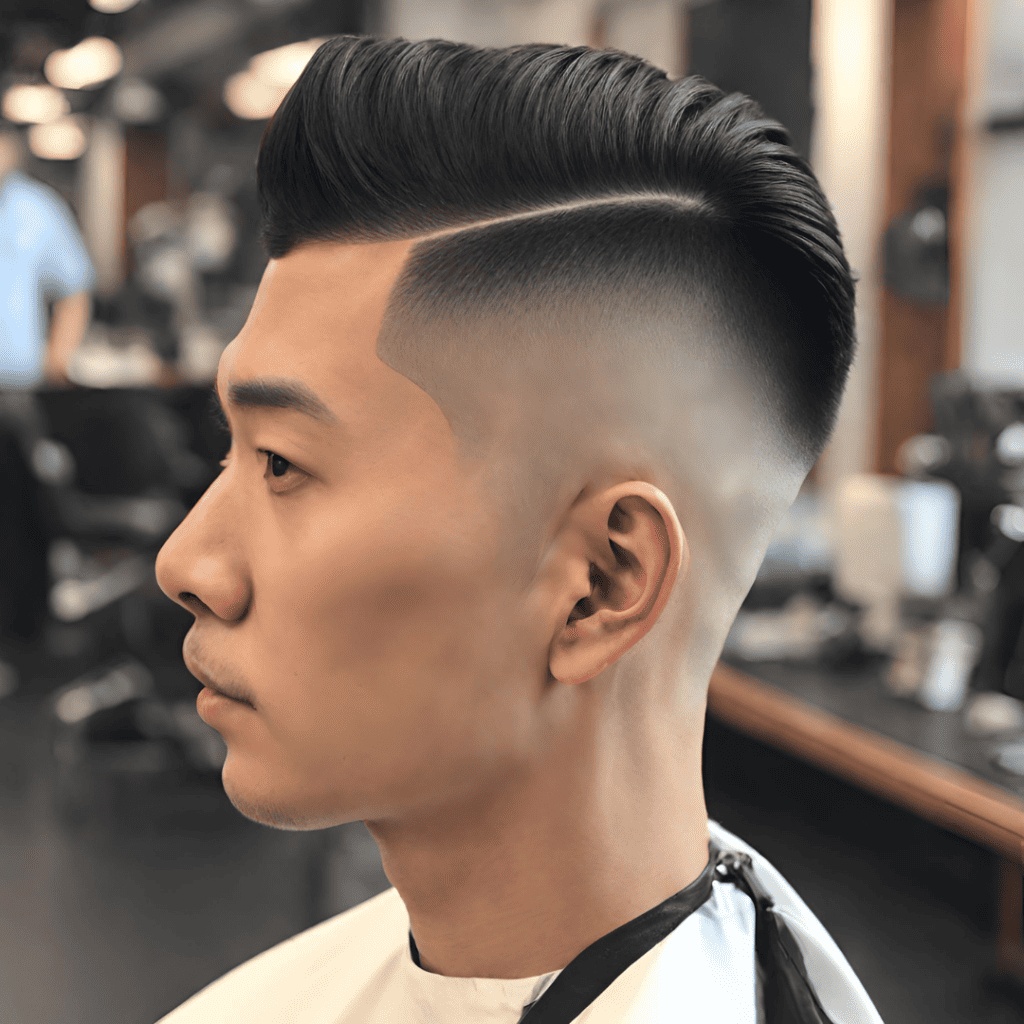
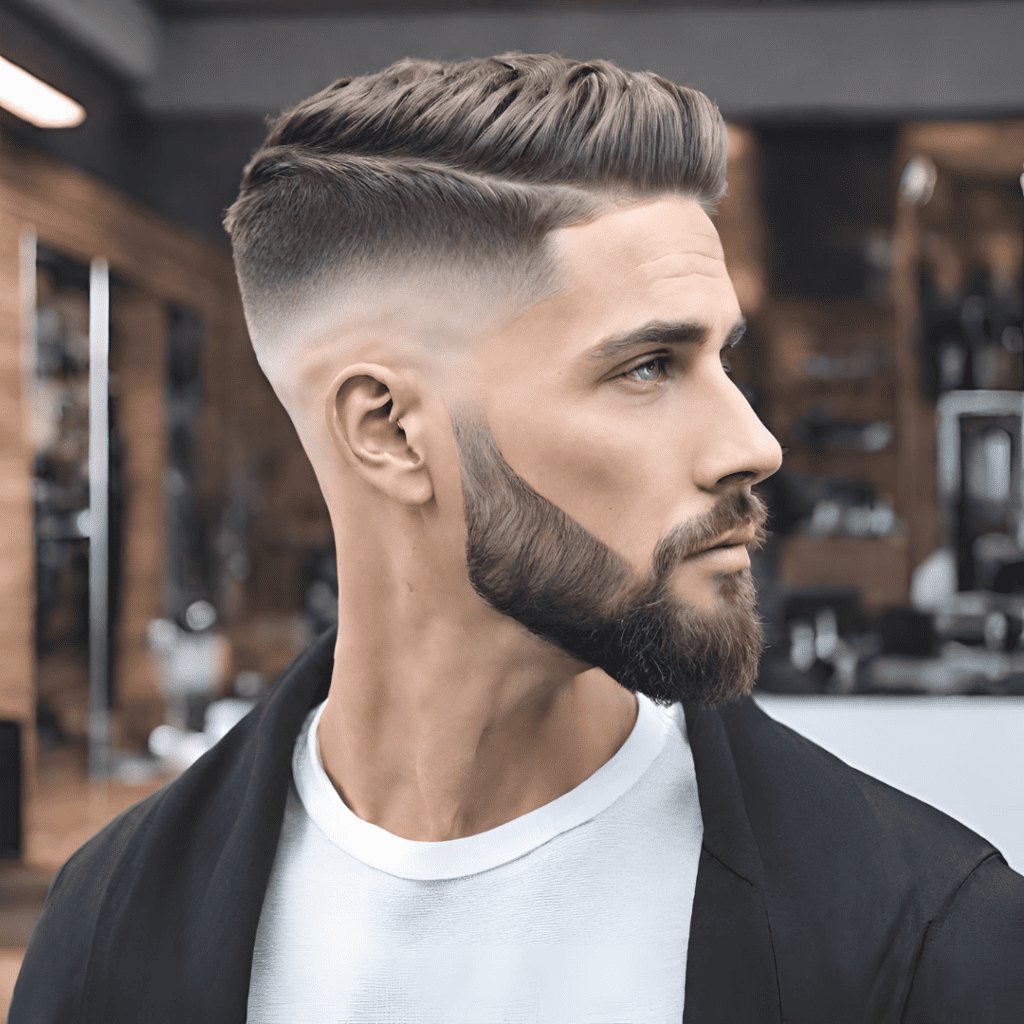
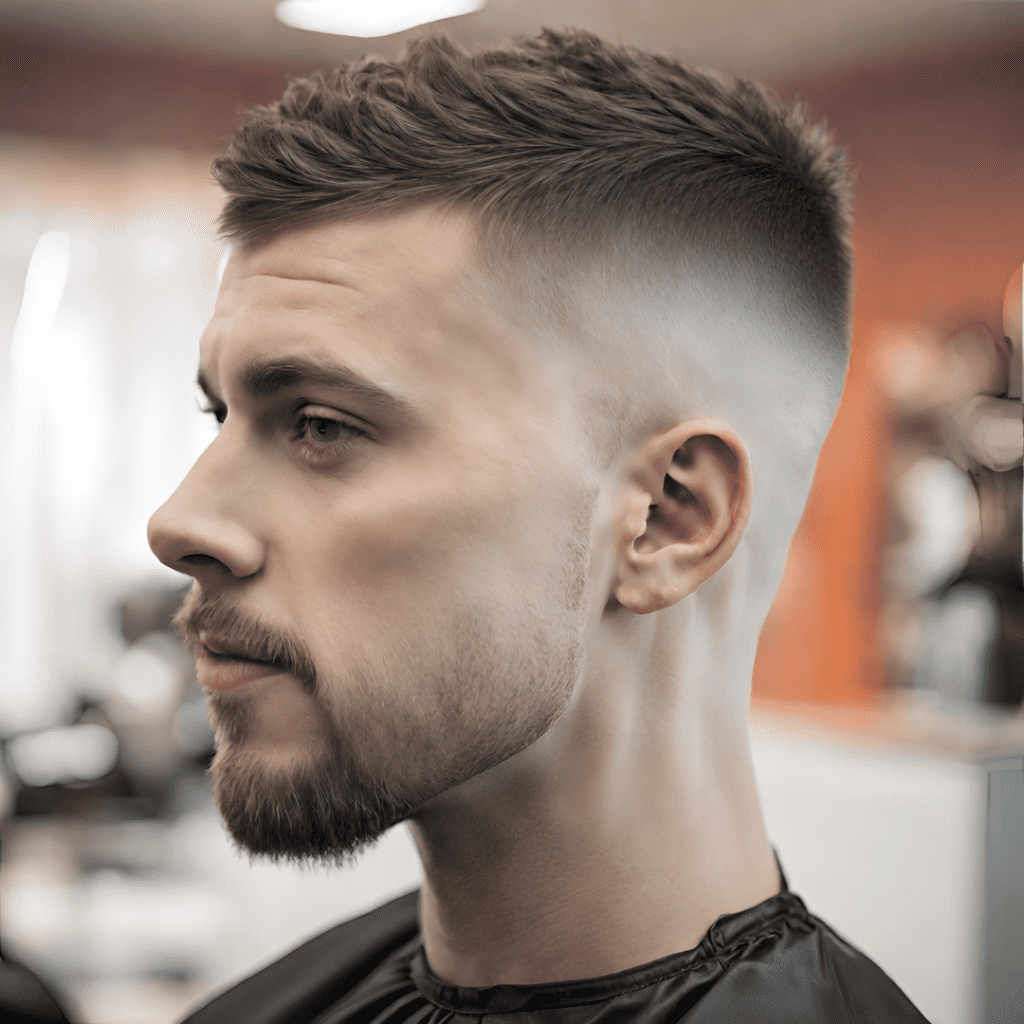

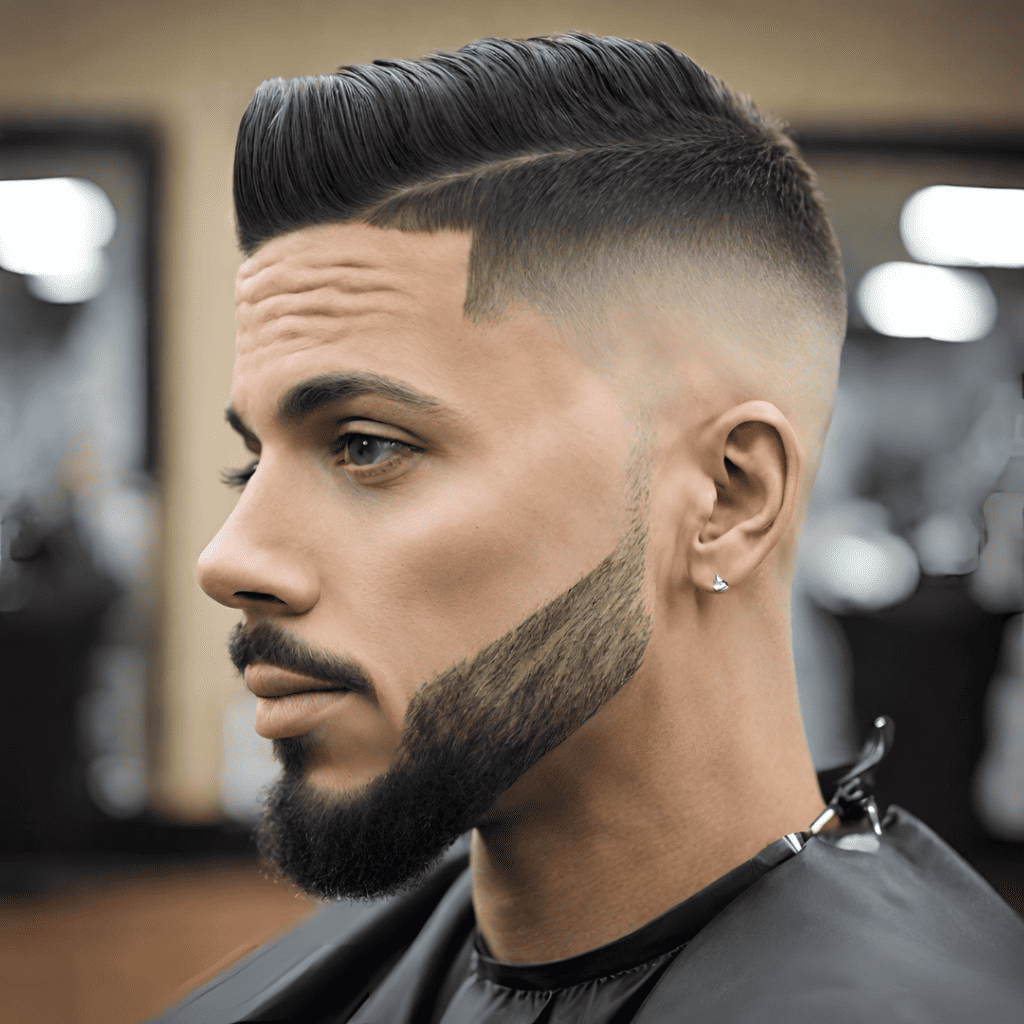

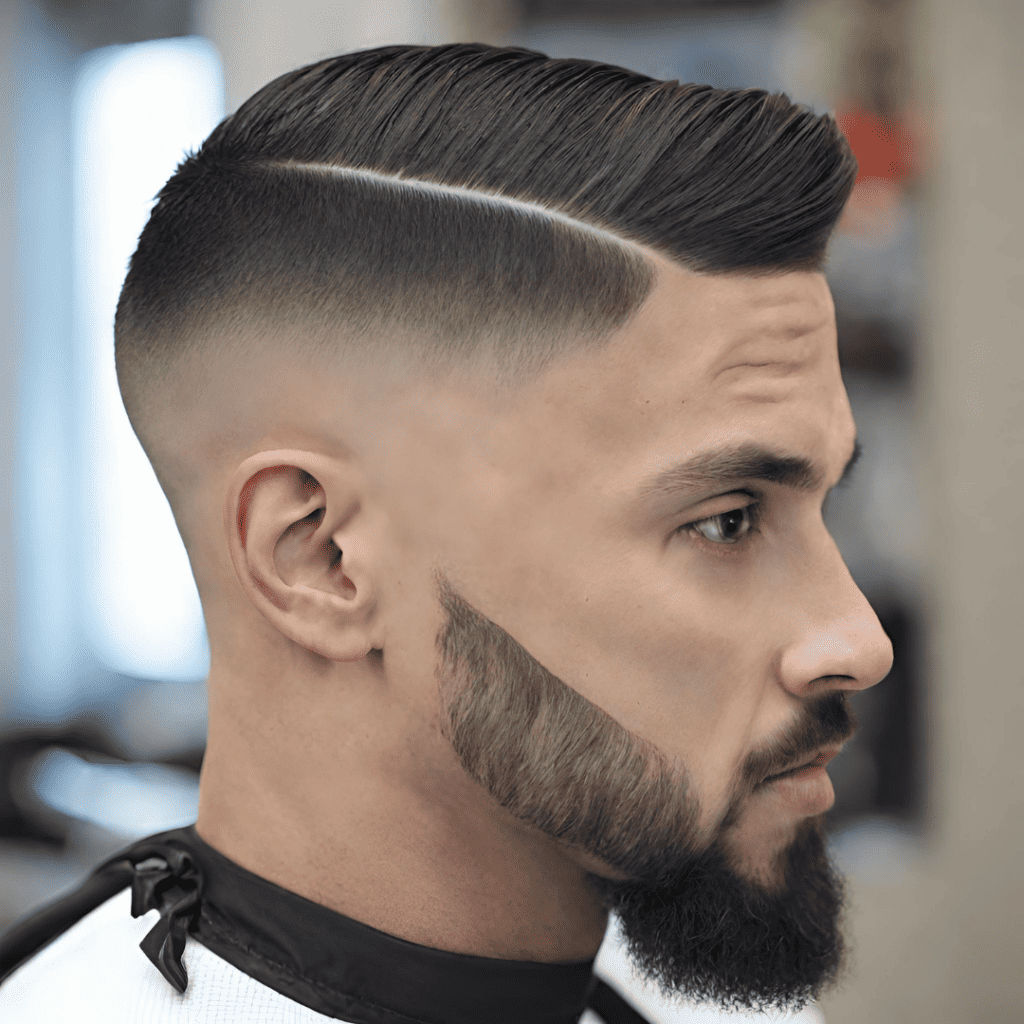
A fade haircut is characterized by a gradual change in hair length from longer hair on top to shorter hair on the sides and back. The specific appearance of a fade can vary based on the type of fade and the individual’s preferences. Here’s a general description of what a fade haircut looks like:
1. Top: The hair on top is longer and can be styled in various ways, such as slicked back, pompadour, messy, or textured. The top length and style can be customized to suit personal preferences.
2. Sides and Back: The sides and back are cut much shorter and gradually fade (hence the name) into the skin, creating a clean and polished appearance. The transition can start at different heights, depending on the type of fade.
3. Transition: The key feature of a fade is the seamless transition between the longer hair on top and the shorter sides and back. The blending and precision of this transition are what make the fade distinct.
4. Defined Hairline (Optional): Some fade haircuts feature a defined hairline, which can be straight, rounded, or curved based on personal preference.
5. Contrast: Fades are known for their contrast between the longer hair on top and the shorter sides and back, creating a sharp and eye-catching look.
6. Versatility: The fade haircut is versatile and can be adapted to different face shapes and styles. Depending on your choices, it can range from a classic, polished appearance to a more contemporary and trendy look.
The specific appearance of a fade haircut can vary based on the individual’s requests, including the type of fade (low, mid, high, or skin), the length of the hair on top, and any additional styling preferences. It’s a highly customizable haircut that offers a polished and modern appearance with room for personalization.
Conclusion
The Fade haircut has transcended its role as a mere hairstyle to become a cultural legacy rooted in indigenous traditions. It stands as a reminder of how indigenous cultures adapted to the impact of colonization.
Although it may have faced ridicule in the past, the Fade haircut has transformed into a symbol of pride for many who embrace it today. As its popularity and recognition continue to grow, it becomes essential to appreciate its historical and cultural importance.
Amazing Fade Haircuts Ideas
In search of a fashionable and adaptable haircut? Explore the Fade cut! This widely embraced style incorporates a fade on the sides and a taper cut in the front and back, making it suitable for various hair textures and styling preferences.
Whether you prefer a fluffy or textured look, there is a wide array of fantastic Fade haircut options available. Embrace your distinct identity and cultural background with this chic haircut. Give one of these fantastic Fade haircut ideas a try to captivate attention and revamp your appearance today!
Fluffy Fade Cut
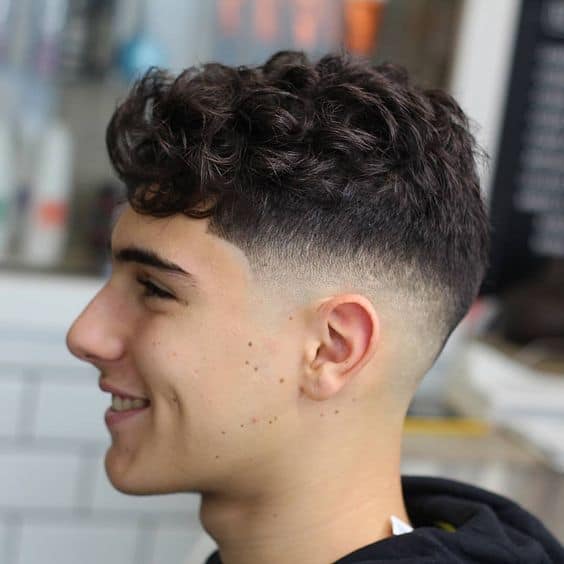
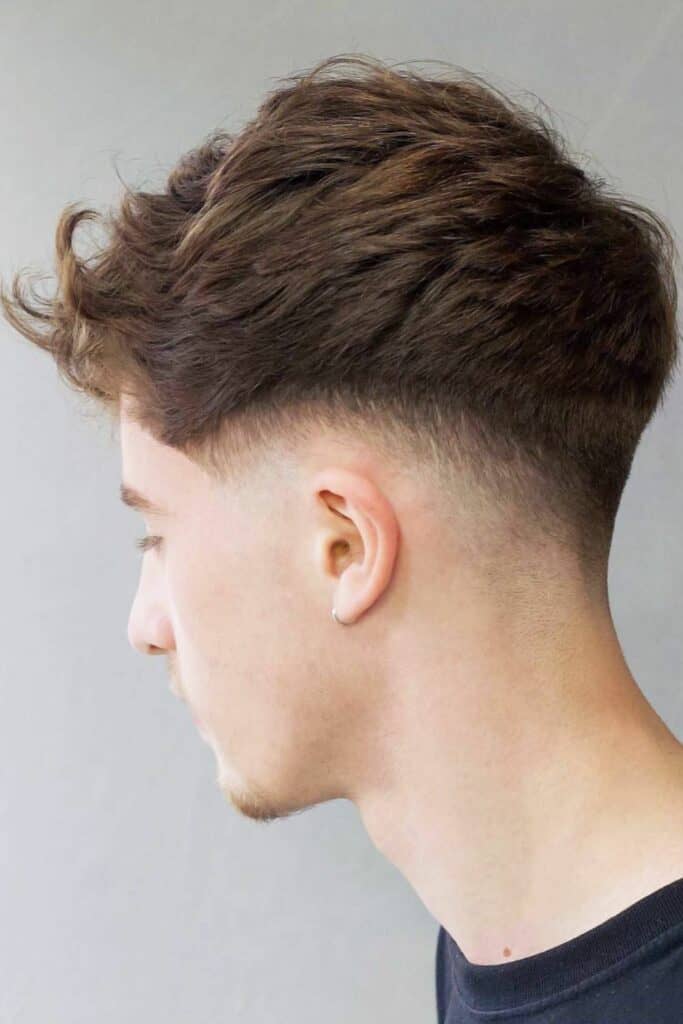
The Fluffy Fade Cut is a version of the classic fade haircut, characterized by a smooth transition from longer hair on top to shorter sides and back. What sets it apart is the textured and voluminous appearance of the hair on top, achieved through specific cutting techniques that create layers and dimension.
The top can be styled in various ways, like messy or tousled, offering a relaxed and modern look. This trendy style combines the polished appearance of a fade with the added dimension and fullness of a textured top.
Fade Cut Curly Hair

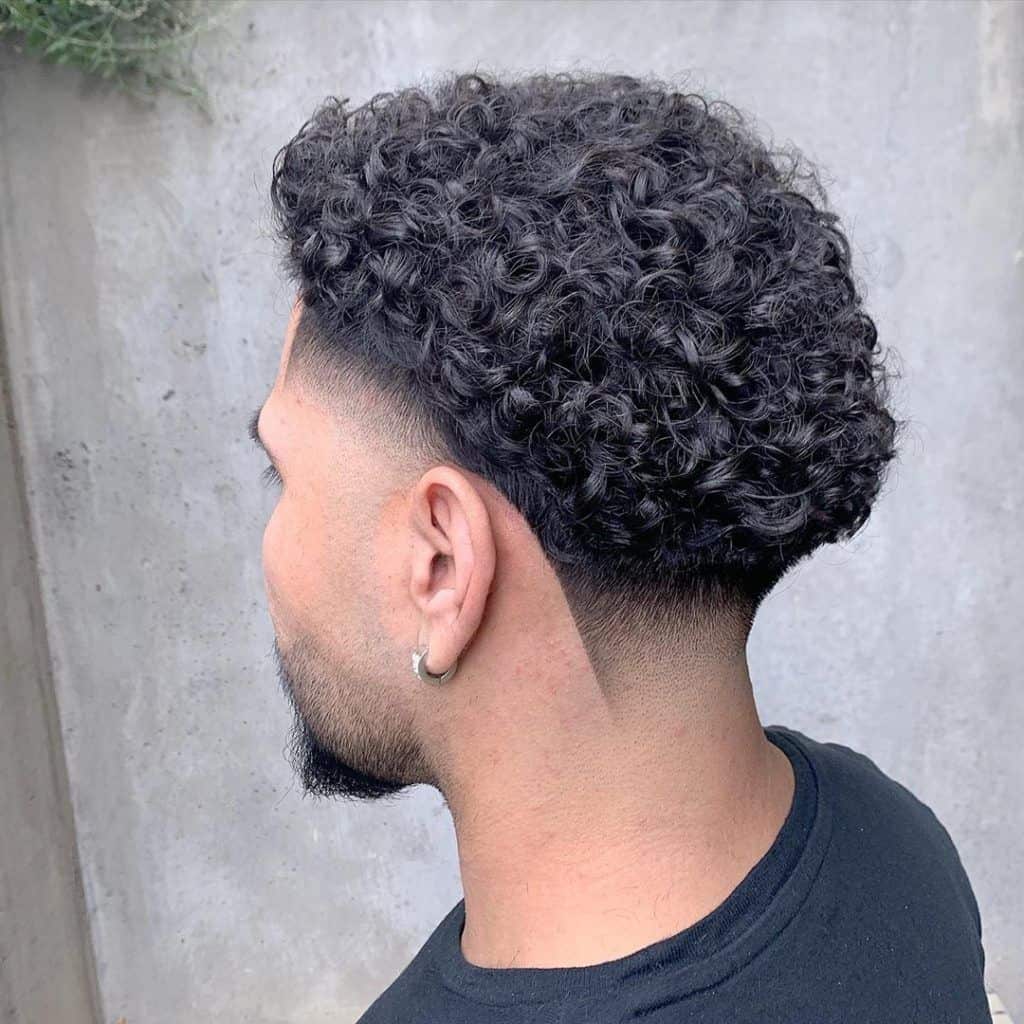
The Fade Cut for Curly Hair, also referred to as a Curly Fade, is a modified version of the traditional fade haircut, specially tailored for individuals with curly or wavy hair. It involves a gradual transition from longer, naturally curly hair on top to shorter sides and back, retaining the fundamental characteristics of a standard fade.
What sets it apart is the curly texture of the hair on top, which contributes to a distinct and stylish appearance. This style combines the sleek and well-groomed look of a fade with the natural texture and depth of curly or wavy hair. It can be adapted to accommodate different curl patterns and top lengths, allowing for a personalized and fashionable result.
Messy Fade Haircut
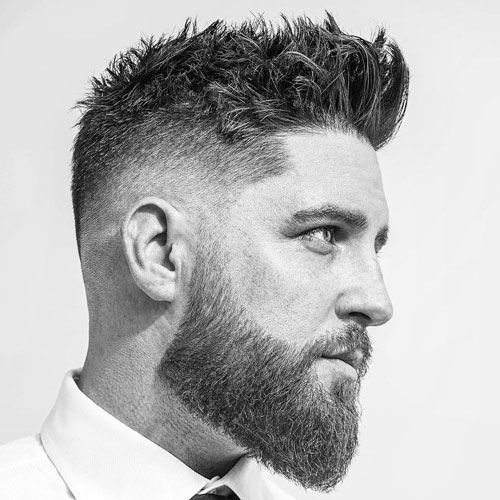
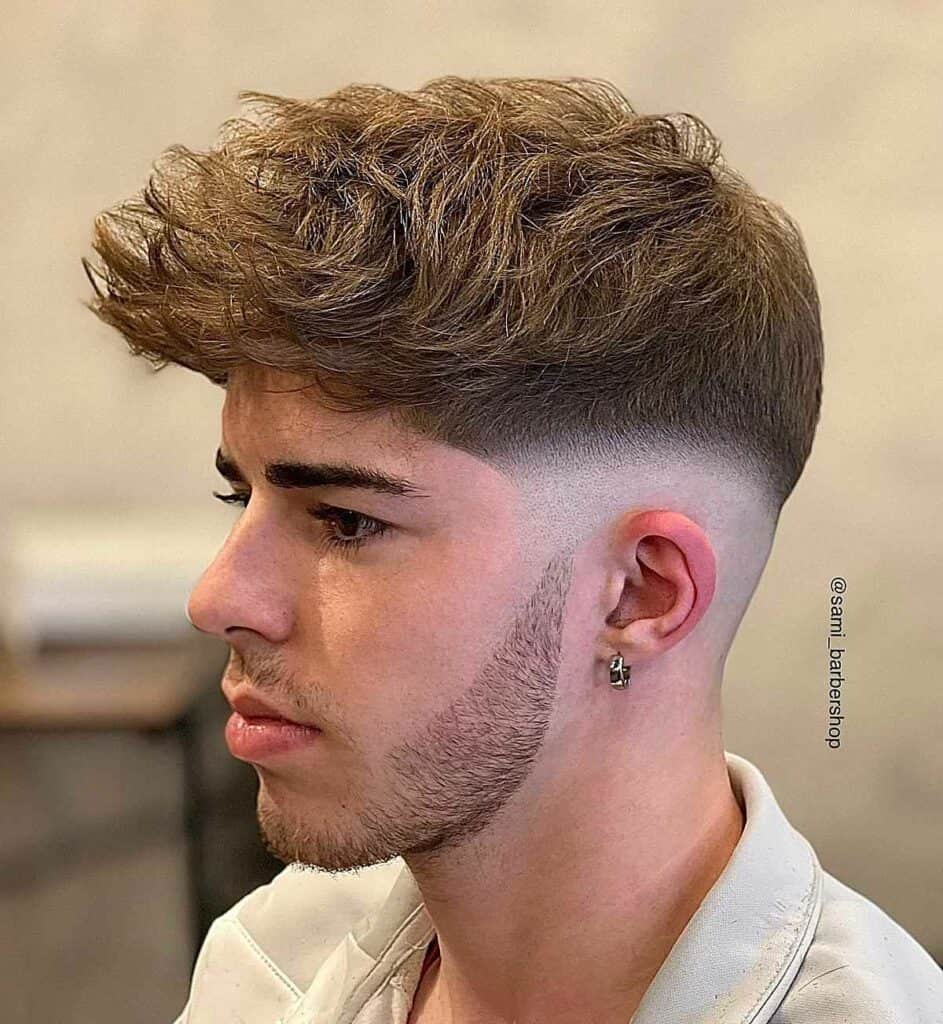
The Messy Fade Haircut is a modified version of the traditional fade haircut, where the hair on top gradually transitions from longer to shorter on the sides and back. What distinguishes this style is the deliberate effort to create a messy and tousled look with the hair on top.
While the sides and back maintain the clean and polished appearance characteristic of a fade, the top is intentionally styled to appear relaxed and disheveled. This hairstyle marries the structured look of a fade with a casual and contemporary vibe, making it a popular choice for those seeking a less formal and more trendy appearance.
Fade Haircut Fluffy
A Fade Haircut Fluffy is a modified version of the traditional fade haircut, featuring a seamless transition from longer hair on top to shorter sides and back. What distinguishes this style is the emphasis on creating a textured, full, and fluffy appearance with the hair on top.
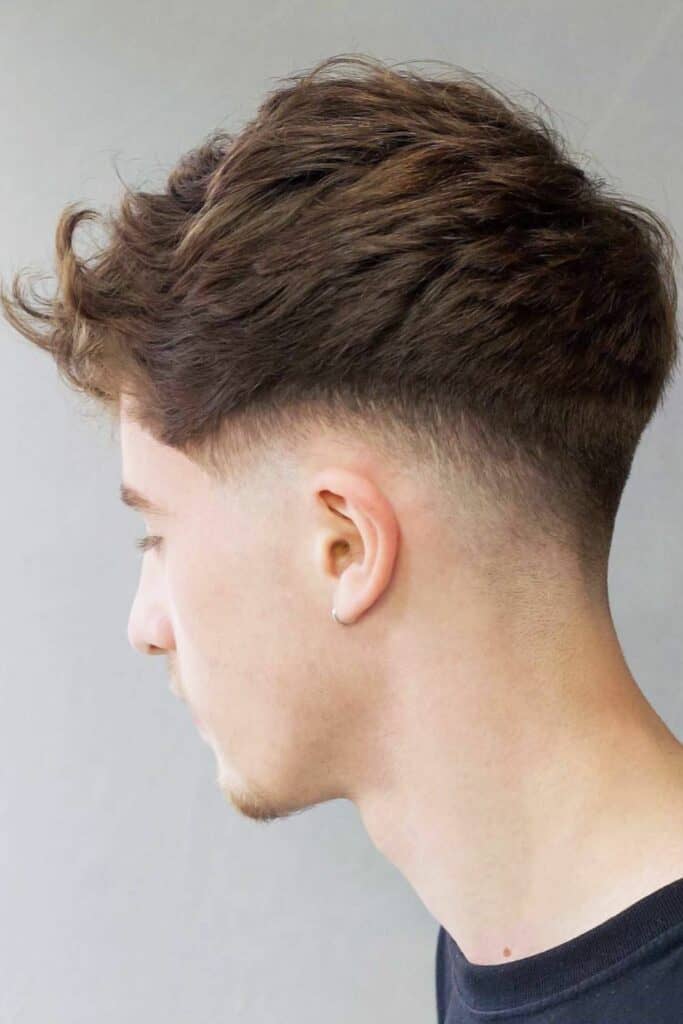
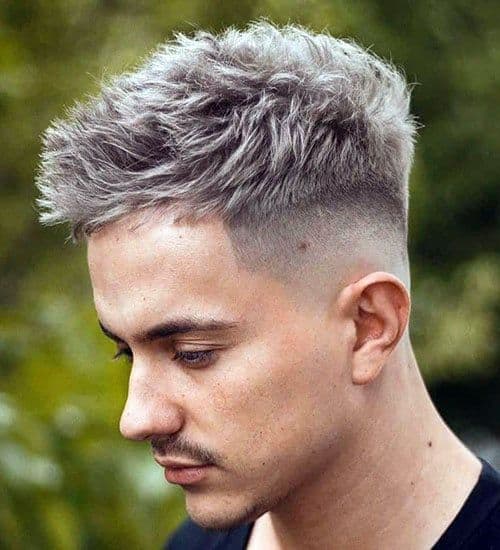
To achieve the fluffy effect, specific cutting techniques like layering and texturing are employed, adding volume and dimension to the hair on top. The sides and back maintain the sleek and polished look typically associated with a standard fade. This hairstyle offers a combination of the clean, well-groomed appearance of a fade on the sides and a soft, airy, and modern appearance on top.
